Today I’m pleased to interview my longtime SCBWI friend, Terry Catasús Jennings, about her latest book, THE LITTLE HOUSE OF HOPE, published by Neal Porter Books and illustrated by Raúl Colón.

The book received great reviews in a wide selection of publications including the New York Times. School Library Journal’s review concluded, “Colón’s trademark watercolor and color pencil illustrations begin by showing the uncertainty of a new place with a gray, almost stormy sky as the backdrop to the unfamiliar, and then move on to depict a loving family, warm home, sunny outdoors, and the hopes and dreams of many who face difficulties in their attempts at a better life. The poetic Spanish text … deftly conveys these hopes and fears in an accessible way to young readers. VERDICT A great selection that honestly presents the hardships and the victories of families working hard for a bright future.”
Terry, welcome to Picture Book Builders! Thank you so much for offering a signed book for one of our lucky readers! Folks, see below for details. (Edited to add: there seems to be a glitch that’s blocking some people from commenting. If that happens, go ahead and send me an email at kimnorman@mac.com and I’ll toss your name in the hat for the random drawing for the book.) So, Terry, tell us about the encounter that prompted you to write this book.
Kim, first, thank you for inviting me for this chat. I’m delighted to be talking with you. You’re right, it was an encounter that prompted me to write The Little House of Hope. A not-very-nice encounter. A Realtor friend told me that he didn’t rent to immigrants. He said they lived three or four families to a house and they always trashed the place. It was like a slap in the face. In Spanish we call it a bofetada, that has a better ring to it, doesn’t it? This “friend” knew I was Cuban. How could he generalize like that? How could he say those terrible things in front of me? But the funny thing is that at first, it was a “how dare he” say something like that in front of me? Still, that attitude was so wrong, and so emblematic of the reaction towards immigrants by many people, that I kept chewing on it and chewing on it. Being mad that this person who was my friend was so short sighted. And if he had that attitude, what hope was there? Somewhere in the stewing, my memory stirred. WAIT! There were three families in the first house where we lived when we first came to the United States. One family lived in the garage, and the other two shared the regular part of the house. Girls in one room, boys in the other. One set of parents in one room. My parents on the living room couch. And if we hadn’t lived like that, we would have been homeless. And what would have happened to us? Sharing that house allowed my parents to find jobs and save a little money to rent a home of our own. Those three families lived there for about a year. Then as some of us found places of our own, other families moved in. AND, we did not trash the house.
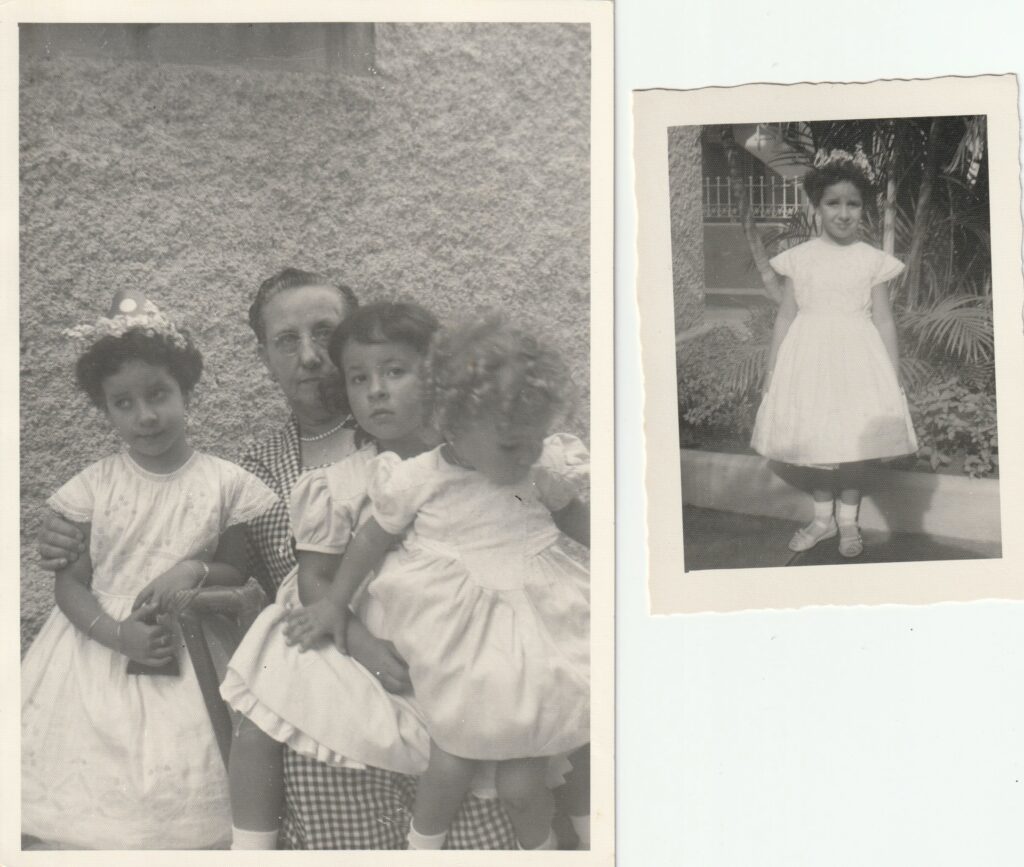
At this point, when I remembered that, the book began to form in my mind. It wasn’t oh I’m going to write a book, but the words, sentences and paragraphs began to form in my mind. And I sat down and wrote. And I wrote the story very quickly. At first it was more about the house that was giving shelter and an opportunity for the immigrants to get on their feet. At one point it had villains—neighbors who did not want the immigrants to live in their neighborhood, because there were too many cars in the driveway, but then there was a fire and the immigrant family saved everyone and then they were accepted. Eventually it morphed back to what it actually was, the actual story of my family. A family who had just gotten a house of their own and then opened up their home to others until they could get on their feet.
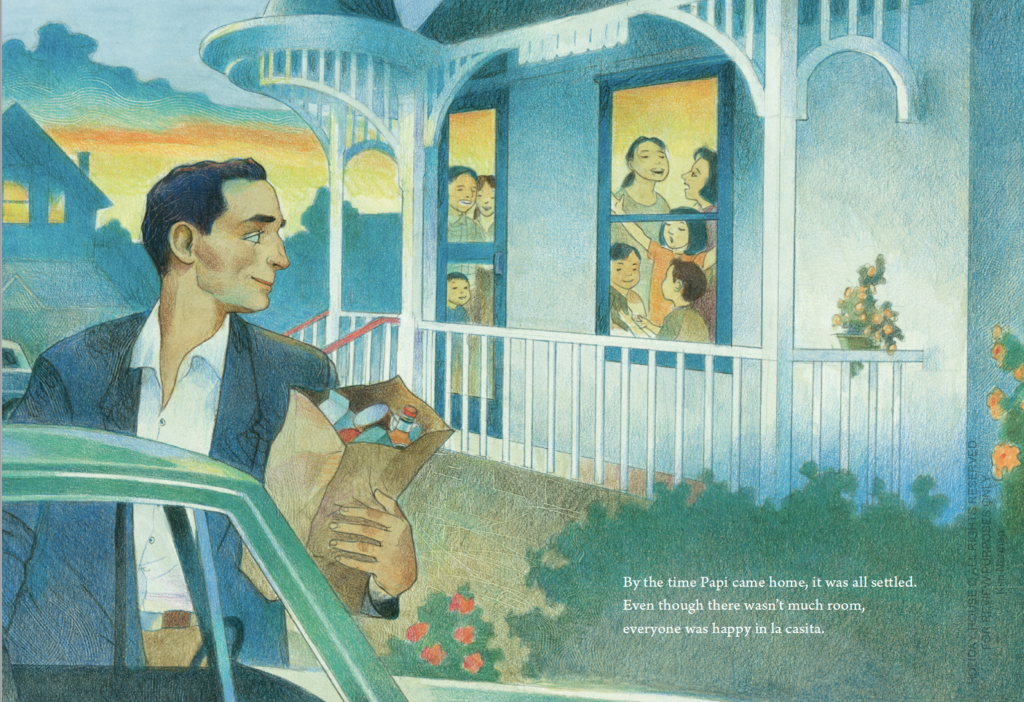
I wanted to use the book as a vehicle to build understanding in young readers, and perhaps even their parents, because if we understand the whys and the hows we can build empathy. With empathy, perhaps hands will reach out to immigrants instead of rejecting them. I honed in on trying to provide a vehicle to explain the immigrant experience—the reasons why families might emigrate and the difficulties they face once they land in a new country. And the story is pretty universal, isn’t it? It’s not just about Cuban immigrants coming to the United States. It’s about any person who has to leave their birth country and settle in another. That’s the great thing about it.
And out of that anger that I originally had I hope to bring understanding. And hope.
It was not a story that went through many iterations, and Neal Porter expressed interest in it within two hours of my agent having sent it to him, and we had an offer in two weeks.
Because it mirrors experiences in your own childhood, did you find it challenging morphing your own story into fiction? And did fictionalizing the story make it harder or easier to write?
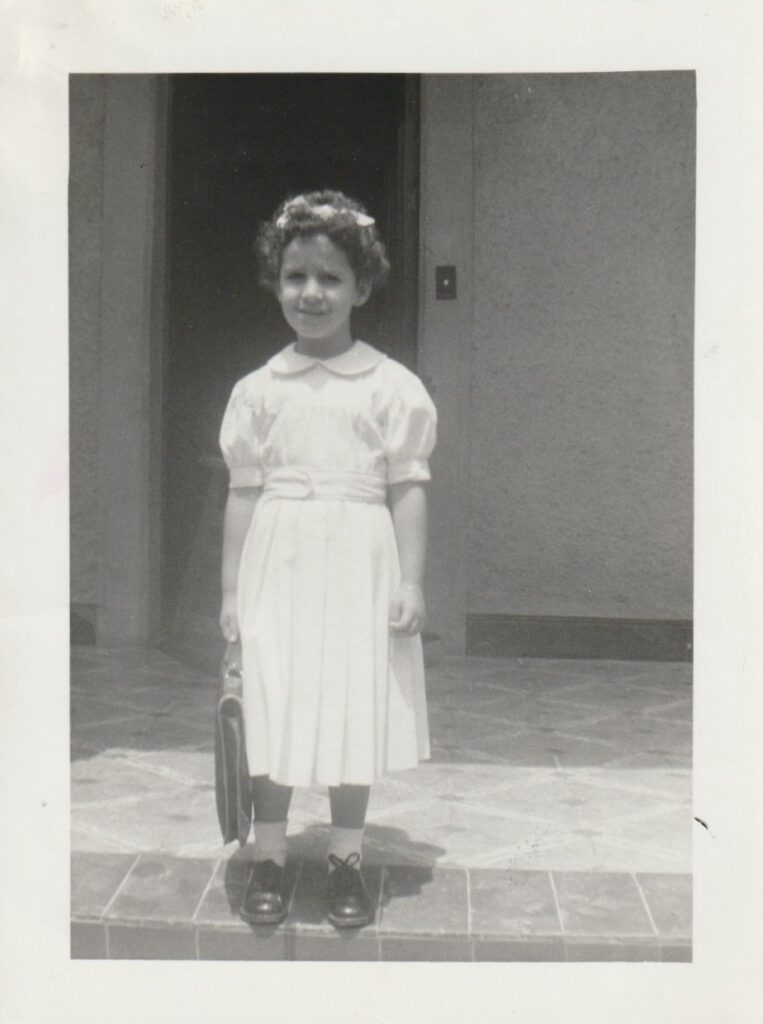
Just about everything in the story happened to my immediate family or one of us, but I did do a lot of rearranging. For instance, my father was taken by soldiers during the Bay of Pigs invasion, and we didn’t know where he was for three days. We thought he’d been shot. He worked for Ché Guevara at the Cuban National Bank and family lore says that because of that, he was freed after three days. Most of the people who were taken during the Bay of Pigs were not freed. So I had two problems. I needed to express what happened to most people, so I had to have the person who was taken by soldiers to not be heard of again. But then if I did that, the family wouldn’t have a father. And it was important to me to have a whole family—a complete family that was now safe in the new country. So I gave my father’s story to Conchita’s husband. She is the mother’s sister. The house that smelled like old wet socks was a house we rented, just my immediate family. It wasn’t the house where we all lived. I think fictionalizing the story made it easier to write because, man, I wouldn’t want to spend a lot of time re-living those three days when my father was gone. There was bombings, people surrounded our home and yelled that Papi should be executed. That would have been hard. One outright lie was the “memories of home bubbling on Mami’s pots.” My mother could not boil an egg. It was my aunt whose food brought memories to us. It was fun, actually, once I got over being so mad. Therapy, I guess. And working with Neal Porter and getting to the heart of the story was amazing.
How tickled were you to learn that Raúl Colón would be doing the illustrations? His work is amazing. To me, his work has the lushness of late 19th to early 20th century lithographed posters from around the world, and yet the textures and composition feel modern.
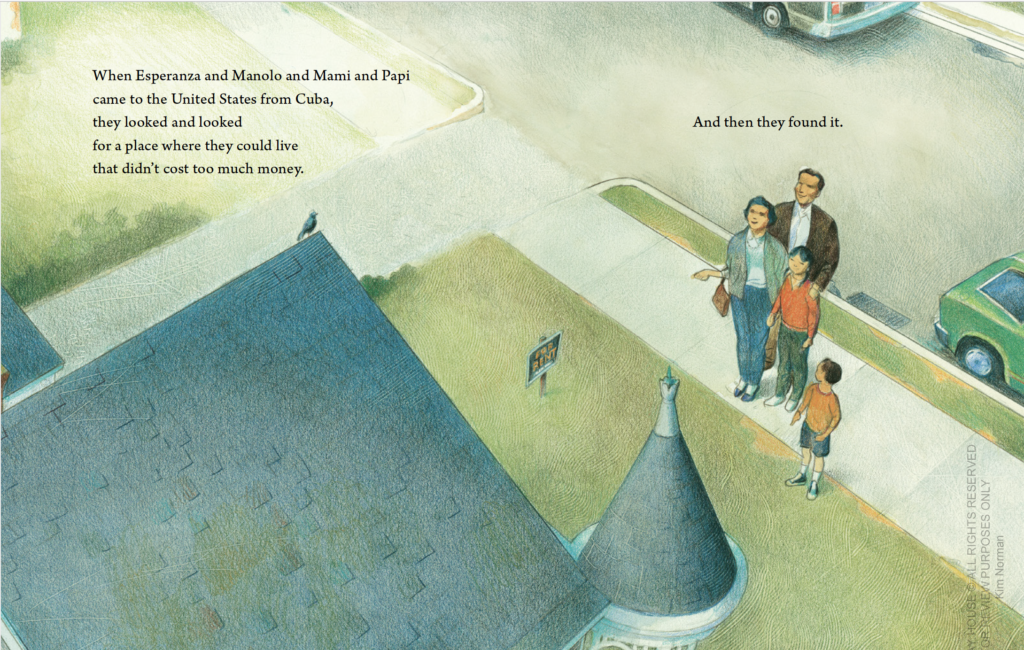
Tickled! Jump-up-and-down-and-yell tickled! RaúI Colón is an icon. I actually had one of Raúl’s books on my shelves. It is Good bye, Havana, Hola, New York. I had bought it as research for a different book, and I’d been smitten by his work. So I was over the moon excited that Neal offered him the story and that he accepted. It’s interesting that you talk about the time-stamp, let’s say, of his work. I feel the same way. The Little House of Hope, I think, could take place any time. Raúl said he aimed for the late eighties. The funny thing is that my perspective on the book was the 1960s and Neal thought it took place right now. So between the three of us, we made it timeless.
Your office workspace looks heavenly! Who wouldn’t be inspired to write, surrounded by all those books? Can you tell us about your process as you work?
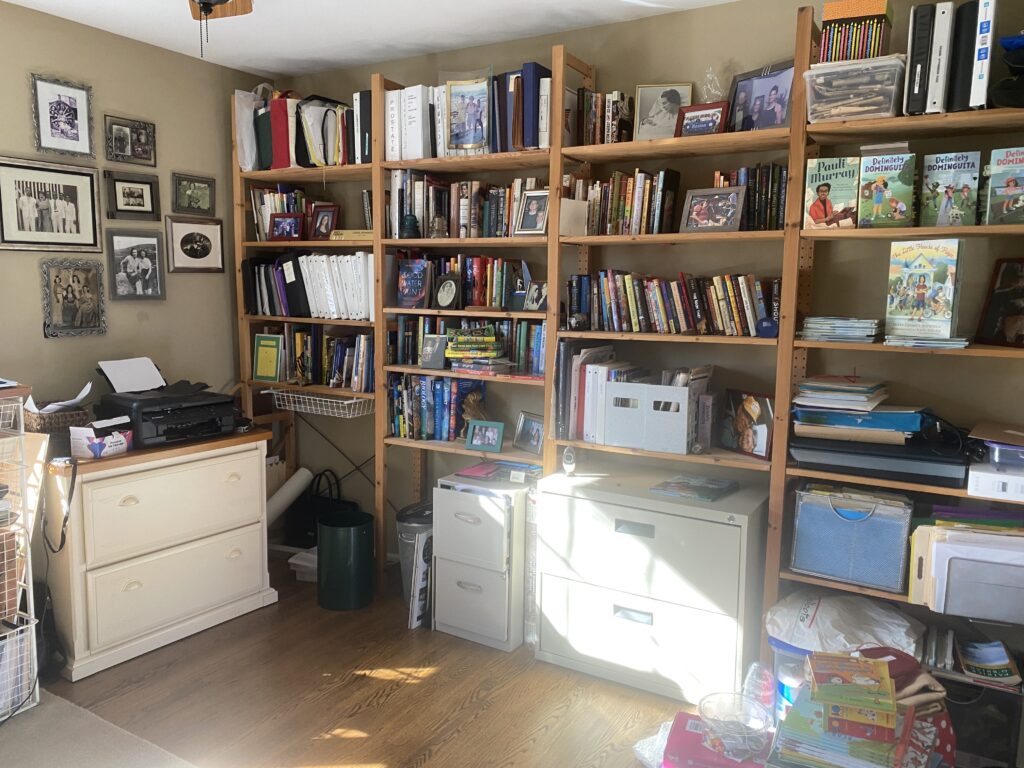
Those books are inspiration and research books. I am surrounded by friend’s books, and books that I admire, so that when I want to check out, like how did Kim do this in Crocodaddy, I can just reach for it. [[ Kim interjecting to say two things. First, “As, shucks about my Crocodaddy.” and second, I do the same thing, hanging onto a large collection of kids books even though there appears to be no grandbabies on the horizon. Hey, it’s not hoarding if it’s for work, right?]] They’re grouped by novels in verse, Middle grade series, Non-fiction picture books, picture books, and just plain old books by friends that I can’t bear to give away after I read them. And then there are all the books I’ve bought for research. Sometimes I stand up while I write, and sometimes I sit. My process for any kind of book is to figure out the beginning. You know, the hook. That first image. There’s an idea of a book, and I know that will sound trite, but for me it really starts with the beginning. I need to get that character’s voice in my head, and write the first few chapters or a whole picture book as if I was a pantser. After that I pull back and write loose outlines if it’s a novel, or work on getting a pb draft to the point where I like it.
When I feel like a pb is actually pretty good, it goes to writer’s group. That’s when I find out how much more there is to do. I often feel sorry for my critique partners because they have to look at the same pb over and over again. But in the end, it’s all worth it. We’ll see. I have a bunch of pb’s on submission and ready to go on submission. For middle grade, I submit ten pages to my critique group every time we meet, but I keep on writing. I’ll get to the end of the book before my critique group gets through with the whole thing, so then the revision process is really on my own. I get a couple of friends who are kind enough to comment on the whole book, then it goes to my agent who is a very editorial agent. I have a lot of things in the works, right now. Another thing that’s happened is that I have old stories that I wrote a million years ago, but having worked now with several editors, I have learned so much that I feel like bringing back those old books and revisiting them. I just finished a revision on a story that I started in 2008. It is now a novel in verse. Fingers crossed!!!
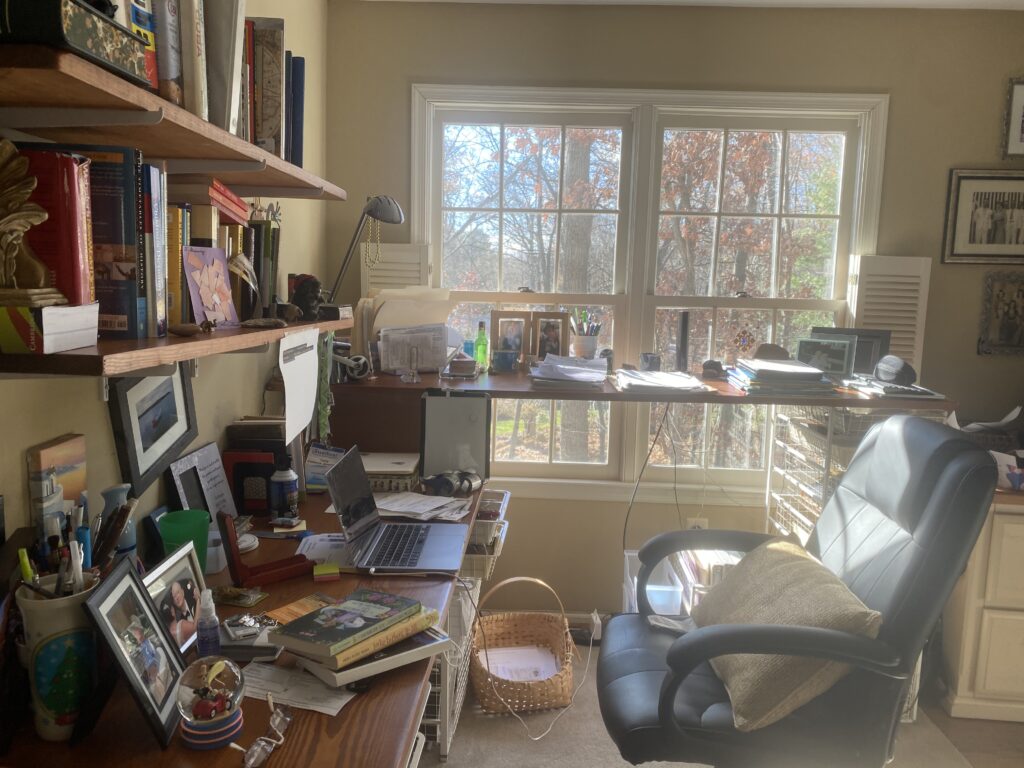
Here’s where I usually get lazy and ask my interviewee to answer the question they WISH I had asked. So Terry, take it away!…
The question that I would like someone to ask me about The Little House of Hope is what I have learned, Kim. There has been a lot of soul searching, and thinking in depth about the immigrant experience, about the feeling against immigrants and about how the immigrant experience is not monolithic. You know, my experience, coming from Cuba in the 1960s was much, much different than what a current immigrant will experience. This forced me to really examine all the many reasons why people leave their country of birth, and I learned all this, not in order to write the book, that was the book, but as a part of developing my author visits. When you talk to young readers, as you well know, you have to tell the truth. You can’t generalize. You need to tell the whole truth, yet you need to boil it down to something they can understand. I looked at why people emigrate. Why would you leave so much behind to come to another country? And when you come to understand the common reason, it’s that for most folks, life in their birth country is untennable. It may be from war; political unrest, like it was for our family; drug violence; gangster violence; famine, (think of Andrea Wang’s Watercress); even a natural disaster—when you live in an island and it gets wiped out by a hurricane or an earthquake, you may have to leave so that you can live. There is also the thought that many people come to the United States strictly for jobs. You know, if there are no jobs, no food, no way to keep your family alive, that is a very compelling reason to leave.
That untennable position was where I landed. You leave so much. You leave loved ones, everything you know, your language, everything you’re comfortable with. You know that when you come it will be difficult. I can’t imagine anyone would leave so much behind if life was possible in their country of birth.
Then I explored what it feels like to be an immigrant. I just spoke to a group of Venezuelan immigrants who were brought to DC on buses from Texas. How do they feel right now? It has all been very different.
Then I have met other folks who tell me, they didn’t leave their birth country because of need, but because, say, their parents came to study in the United States and stayed. They have a totally different experience. One thing that they have, is the ability to return, which many immigrants of need don’t have. I have not returned to Cuba. It’s been sixty years.
The other thing that I learned, that I like to make very clear to my young audiences, is that as immigrants we bring something with us, and it is important to not forget that. The list of the contributions immigrants have made to the fabric of the United States is staggering. I tell the young readers that I brought my words, which allowed me to write The Little House of Hope, but also fun books like Definitely Dominguita, and books that teach science, and books that teach history. I tell them about a young Colombian aerospace engineer, Diana Trujillo, who is in charge of one of the teams that manage the Mars Perseverance rover, and Dr. Katalin Karikó who developed the method to deliver the Covid vaccine. Most immigrants contribute to their communities in large ways and small ways, like Conchita, the sister in the little house, who took care of children so others could work.
Now having said all that, the other thing that I have learned as a result of this book is that regardless of why immigrants come to the United States, and what stage of immigration they are in—first generation, third generation—we all see a lack of representation in children’s literature, and this lack of representation means that we are invisible. We have no worth, because if we had any worth, wouldn’t someone write a story about us? Wouldn’t someone publish a book about us?
Kim, you probably didn’t want all this, and I bet you already know that as of 2020 more than 54% of the school age population is “other?” In those statistics I’m only including people from other ethnicities and Black Americans. (These statistics are from the If you include those who are “othered” because of religion, sexual or gender preference, ability, mental health, the numbers are much bigger. And those children are not represented in their literature in commensurate numbers. That is a crime, and I am so happy that Neal Porter and Holiday House, as well as Aly Heller and Simon and Schuster, have allowed me to do my tiny little part to remedy that.
Kim, thank you so much for giving me this opportunity to chat with you. It is lovely. And thank you for your generosity towards other authors. I will never forget that we met at an SCBWI function, and I was just about to have my first book come out, and you arranged for me to sit in on one of your author visits. Thank you.
I’m so very glad we met, too! Gosh, I forgot about the author visit, but I do remember immediately liking you and being happy to make another smart, talented friend through the MidAtlantic SCBWI. Although, of course, it’s huge that I got my “big break” through a MidAtlantic conference, I think it’s just as huge that I have enjoyed decades of cherished friendships with so many wonderful people who’ve been cheerleaders, shoulders to cry on and generous mentors. Best of luck with this book, Terry, and all those ahead of you!
Folks, don’t stop reading yet: GIVEAWAY info! One commenter on this post will be randomly chosen to win a copy of Terry’s book. So be sure to comment for your chance to win. (Edited to add: as I mentioned above, there seems to be a glitch that’s blocking some people from commenting. If that happens, go ahead and send me an email at kimnorman@mac.com and I’ll toss your name in the hat for the random drawing for the book.) Let’s say by December 31st. Since I won’t be posting in 2023 (see next paragraph), I’ll ask a PBB contributor to announce the winner next month.
Readers, this will be my last official post to the Picture Book Builders blog – for now. I hope to pop in for guest posts now and then and, will of course, stop by every month to see what PBB contributors and guests are up to. Happy holidays to everyone and here’s to a wonderful 2023!
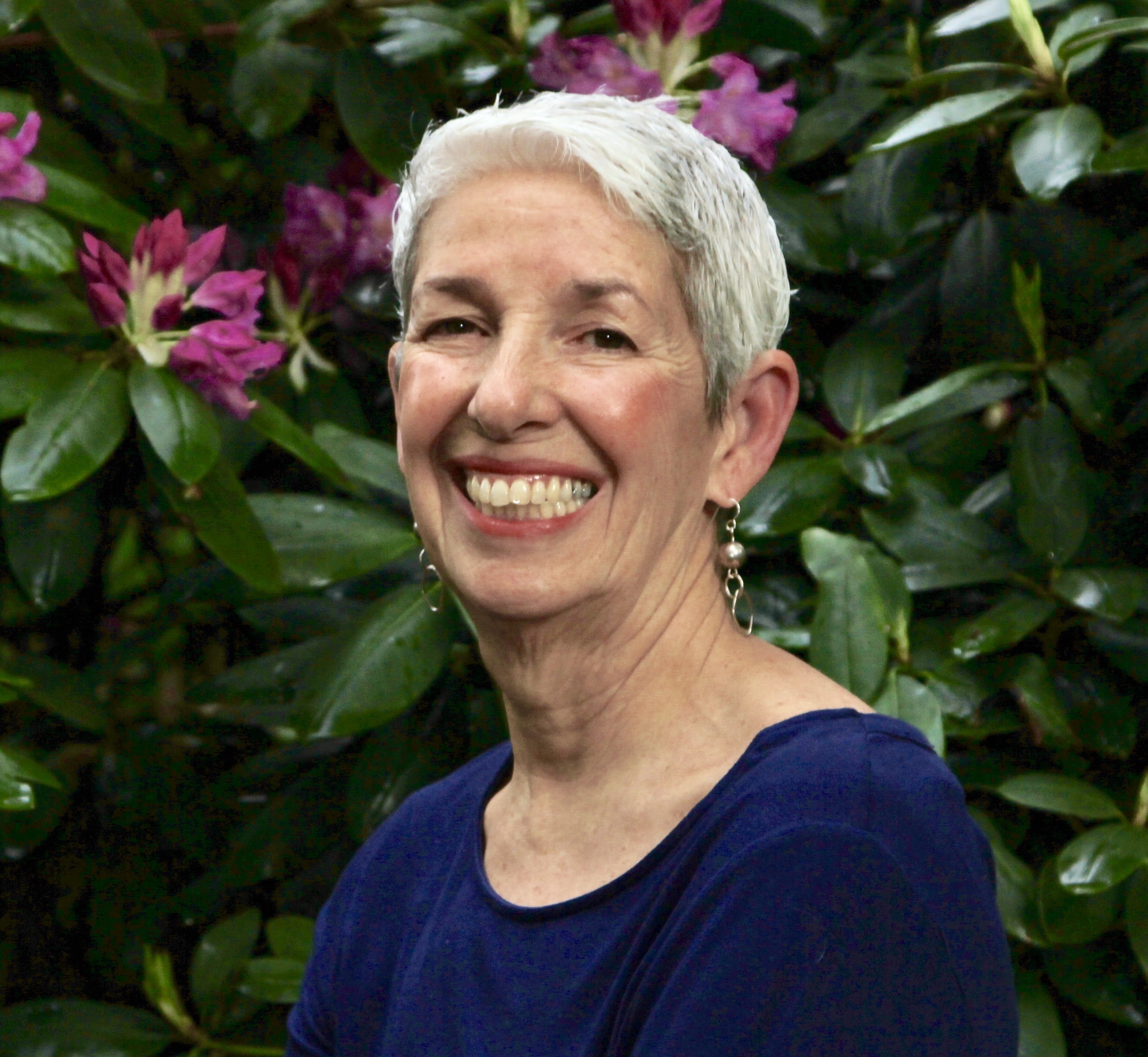
On September 11, 1961, Terry Catasús Jennings landed in the United States with her family after a short flight from Cuba. Their only possessions were $50 and one suitcase each. Her family, including her father, who had been jailed during the Bay of Pigs invasion, was now in a free country. On September 12, Terry found herself enrolled in seventh grade, drowning in a sea of English she didn’t understand. With time and help, the family thrived. Terry was a late bloomer in her writing career. The Definitely Dominguita series was named SLJ, Kirkus, and Parents Latina Best Books of 2021. Her biography in verse, Pauli Murray, The Life of a Pioneering Feminist and Civil Rights Activist released in February. In The Little House of Hope, a Junior Library Guild Selection illustrated by Pura Belpré medalist Raúl Colón, Jennings portrays her immigrant experience, showing how a helping hand in a new land can make a life-saving difference for a family. She encourages us all to embrace our common humanity. She lives in Reston, Virginia with her husband, and enjoys visiting with her five grandchildren, often encouraging them to bring their parents along. She is a member of SCBWI, Las Musas Latinx Collaborative and the Children’s Book Guild of Washington, DC. Terry is represented by Natalie Lakosil of Irene Goodman Literary Agency

Great interview and I loved seeing the photos and some of the beautiful illustrations! Congrats on the book!
Wonderful interview, Kim. I can’t wait to THE LITTLE HOUSE OF HOPE. It’s fascinating to hear how the story evolved. Congratulations, Terry and Raúl!
“Thanks Ariel, Aren’t the illustrations amazing?
Hope you love the book!!!
Gorgeous book, Terry, and THANKS for the meaty interview, Kim!
We’re going to MISS you around here.
Aw thanks, Jill. It has been such an honor to participate. And I’m so excited it’s letting me comment. (At least… fingers crossed!) Love the blog, Jill. So glad you started it. Hugs!
Thanks, Jill, and yes, we’ll all miss Kim. Life is hard.
I’ve seen this book featured on other blogs and know I will love reading and learning from it.
Thanks so much, Danielle, Hope you get to read it.
Kim, best of luck with your new endeavors. Terry, your personal story is so interesting, and I am glad it led to this book, but I have to wonder about your “friend” who said such horrible things about immigrants. Are you still friends?
What a glorious book.
Everyone needs more empathy! Thanks for writing such a lovely book.
Oh, thank you. I hope that’s exactly what this book does. We need understanding and empathy.
Oh…. Kathy. It’s hard. On the one hand, I wanted to punch him. But better to educate him, I think. But it’s hard. It really is.
Yes, friend, thank you. So glad you’re on this blog. It is so wonderful!
what an amazing story with great illustrations!
I love the illustrations too. They are so perfect. I was very lucky that Neal Porter picked Raúl Colón. I’m glad you liked the story. It is my story and I hoped it would resonate.
Terry
I was so fortunate that Raul was picked to do this book and that he agreed. He is a great partner and a wonderful illustrator.
How neat…thank you for sharing!
Thanks, Katie
Gorgeous book and such an informative interview! Thank you both! Congrats, Terry!
Kim, thanks for all of the wonderful posts!
Thank you, Angie. I am very excited about this book.
I’ve heard Terry speak and it’s inspiring to hear her story.
Yes, friend, thank you. So glad you’re on this blog. It is so wonderful!
Wonderful interview! Such an inspiring story! Thank you both!
Thanks Sydney,
You are always so supportive.
Best
Terry